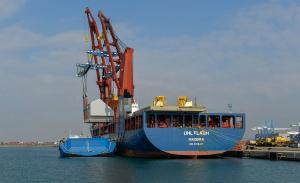From ship to barge, directly
Shipped from industrial facilities located on three continents, the largest and heaviest ITER components are unloaded on dedicated heavy-load quays at Marseille industrial harbour Fos-sur-Mer. The operation consists in lifting the load from the depths of the ship's hold, sometimes rotating it in mid-air to align it with a transport trailer parked alongside the ship and eventually depositing it as carefully and as precisely as possible on the trailer's flat back. The trailer is then loaded on a specially designed barge and transported across the inland sea of Berre to start its land journey to the ITER site. Exceptionally, last week when vacuum vessel sector #8 arrived from Korea, no heavy-load quay was available at Fos and the load had to be transferred directly from the ship to the barge—a rather long and particularly delicate operation.
On Wednesday 9 March, following two days of intense preparation supervised by ITER global logistics provider DAHER, smooth water and a lack of wind at Fos harbour created ideal conditions for the transfer. Barge and ship were placed alongside each other and, while electronic calculators adjusted ballast in real-time, the ship's massive on-board cranes slowly lifted the 558-tonne load. As ITER vacuum vessel sectors are placed perpendicular to the ship's hull in order to minimize the effects of acceleration during the sea voyage from Korea, the load had to be turned 90 degrees so that it could align with the barge.
Once aligned, the load was lowered onto the barge deck and positioned on 16 stillage supports (also called "stools" or "elephant legs") under which the transport trailer was already in place. Small back and forth movements of the trailer allowed for the precise adjustment of the barge's centre of gravity.
Loaded with the vacuum vessel sector in its cabin-like housing plus the 176-tonne trailer, the barge docked at Port de la Pointe on the north shore of the inland sea the following day. Road transportation to ITER is scheduled from 28 March to 1 April 2022.
One final sector expected from Korea will be ready to sail in the first weeks of September. Five other sectors will be delivered to the ITER Organization by the European Domestic Agency.


